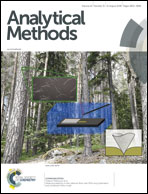Comparison between two derivatization methods of nitrite ion labeled with 15N applied to liquid chromatography-tandem mass spectrometry†
Abstract
The fragmentations of the adducts resulting from the derivatization of nitrite ion by Griess method (formation of an azo compound) and 2,3-diaminonaphthalene (formation of 2,3-naphthotriazole (NAT)) were studied by tandem mass spectrometry (MS/MS). The transition used for quantification was selected according to the highest value of the signal-over-blank ratio (S/B) obtained from each adduct fragmentation. When derivatizing nitrite ion labeled with the stable 15N isotope, followed by liquid chromatography (LC)-MS/MS measurement, the lowest limit of quantification obtained was 5 nM with NAT. The method was applied to study the intestinal permeability of S-nitrosoglutathione, a drug candidate for the chronic treatment of cardiovascular disease. This compound was labeled with 15N and its permeability was studied in an ex vivo rat intestine model using an Ussing chamber.



 Please wait while we load your content...
Please wait while we load your content...